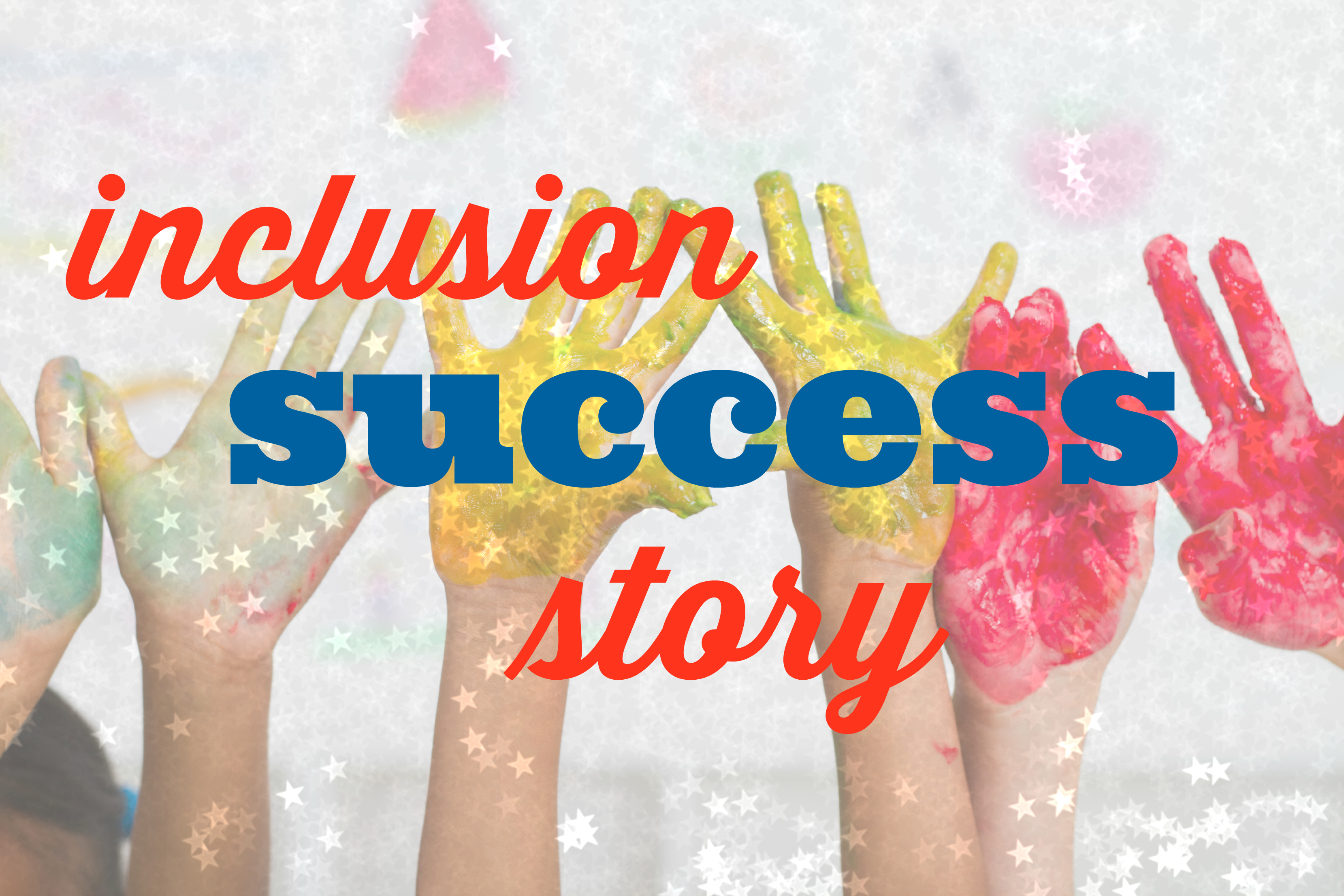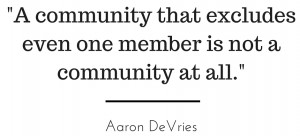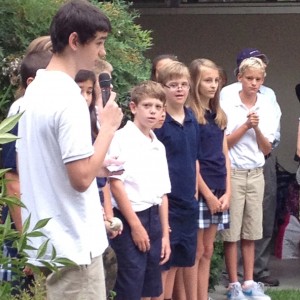“Inclusion really does make us all better”: Tips & success stories from Beth Foraker
February 9, 2016
![]() This post is part of our Fair Is Not Always Equal…Now What? blog series. Stay tuned for more posts in the series!
This post is part of our Fair Is Not Always Equal…Now What? blog series. Stay tuned for more posts in the series!
Today I’m so excited to welcome a very special guest: Beth Foraker of the National Catholic Board on Full Inclusion. We asked Beth a few questions about successful inclusion, and then she shared two wonderful, personal success stories–one of them featuring her own son, Patrick. Read on to learn from one of the most passionate and knowledgeable inclusion advocates in the online community!
Q: What are the most important things educators can do to meet the needs of all learners in a classroom?
A. Lucky for me, I have a good friend who recently completed her masters work in Special Education in California and this is exactly her area of research. She went into classrooms of all different socio-economic levels, different levels of second language learners, different levels of racial and cultural diversity. She found the most inclusive teachers and studied them through observation, anecdotal records, and interviews, and she tried to separate out what inclusive teachers do.
[Beth shared with us some key bullet points from Katie Flores’s master’s thesis, which I’m happy to pass on to you here.]
Inclusive Teachers:
- Work to create a strong classroom community: using positive language, shared random acts of kindness every day, structured and clear expectations
- Allow choices and create self-directed learners
- Work to be engaging–use universal design for learning
- Hold all students to high academic expectations
- Have personal experience–all of the teachers in the study had meaningful relationships with people with disabilities, which makes our work even more imperative to create inclusive opportunities
- Are intentional teachers–they are reflective and adjust as needed
- Collaborate–they work to find resources and support
- See the paraeducator as a colleague and not as an assistant
Source: Katie Flores, third-grade teacher at St. Ignatius Catholic School in Sacramento and passionate inclusion advocate
Q: What would you say to a teacher who thinks the concept of inclusion is wonderful, but believes she lacks the time and resources to make it work?
A. I would say that inclusion does not have to be time-consuming or require resources…it requires a shift in mindset. It requires the teacher to believe that all students have something to important to offer in the classroom and that we really are better off learning together. Once you accept this and weave this into your view of education, you figure out how to make it happen. Google is free. People are doing this all over the world and sharing their results. There are mentors out there. On our website alone we have mentors at every  grade level and principals who are willing to share their experiences and expertise for free. Why? Because they have done it and see how valuable it is.
grade level and principals who are willing to share their experiences and expertise for free. Why? Because they have done it and see how valuable it is.
Q: For teachers overwhelmed by the prospect of differentiating instruction for a classroom of diverse kids, what are some practical steps they can take or resources they can use to help make it easier?
A. First off, I beg, implore, and plead with every teacher to attach a Google image to every single new vocab word introduced into the classroom. Visual supports are not hard and are one of the single best ways to support struggling students.
Use color to help students see first, second, third in multi-step directions.
As Jo Boaler (a truly fantastic math educator that every teacher should know) says: for math instruction, you want to create activities that are “low floor/high ceiling.” What does that mean? That means that the activity has a low enough floor that every single student in the classroom can participate and access the curriculum but it has a high ceiling for those students who are ready to fly and want to delve deeper into the idea. This is a mark of a truly great lesson. I work with student teachers and I am always on the lookout for such lessons…and they happen. Once you see one in action, and you see how engaged your class is and how few behavior problems there are, you want to find a way to keep working toward it. This can be done and should be done in all subjects, not just math.
Notice that I did not say just do the workbook page in the book. Those workbook pages are the opposite of low floor/high ceiling. They are a one-size-fits-all approach that is boring and rarely meets the needs of any student. The teacher has to plan ahead, develop plans for all learners, and consider the stumbling blocks for her strugglers and develop scaffolds for them. This is good teaching, plain and simple.
Be engaging and use technology when appropriate. For instance, if you are talking about Egypt, use Google Earth and put it up on a big screen and watch the map move from their hometown to Egypt. Locating where we are on a map matters. The more we do it, the better we get. By the way, I know someone who did her entire masters thesis on how to use Google Earth in the classroom…it is a HUGE free resource that has so much depth it’s amazing.
I once had a student teacher do PE as a “walk” through California. She put up an image that was famous to California and the students had to do an exercise that went along with it—jumping up to pick oranges off orange trees in an orange grove, walking quickly across the Golden Gate Bridge, climbing Half Dome in Yosemite. This introduced these fourth-graders to their state while getting physical exercise. The activity was accessible to every student at his/her level.
Frontload the information ahead of time for a student with a disability so that when you introduce it to the entire class, the student is seeing it for a second time. Helping a student with a disability become the expert sends a huge message of possibility to the whole class.
Other suggestions:
- Use music, rhyming, and chanting
- Use wait time!
- Use partners or multi-age peer supports
Q: What benefits have you observed as a result of inclusive education?
A. Okay, this is my passion…I could talk about this for days. Let me just say that my son (who has Down Syndrome), Patrick’s story of being fully included in a Catholic school from kindergarten to eighth grade was absolutely transformational for the school. That school had never had a student with an identified disability–but let’s be real, there were plenty of kids struggling and plenty with invisible or unidentified disabilities. Once they accepted Patrick, the teaching had to get better. This is what the research says as well, and this is what we saw happen. Suddenly, because they had Patrick they could acknowledge that other students were not being successful and they felt an urgency to find out why and address it. Today, students in that school are more often supported and identified than ever before and a lot sooner.

Another huge benefit was that Patrick had the joy of being an integral member of the class and school community. He ran for student council and had a very good idea: bring a taco truck to school. No other student council person had mentioned that in his speech. As soon as he shared his idea, the murmurs in the crowd got loud. They wanted a taco truck! Not surprisingly, he was elected…and yes, a taco truck came to school as a fundraiser for one lunch. Imagine the message that is sent when someone with an intellectual disability runs for student council, shares a good idea, and gets elected…and follows through. So, so many important lessons are learned by everyone when that happens. People with Down Syndrome can have good ideas? They can be leaders? Turns out, they can…if given the opportunity and if the school has created an environment where that person feels heard and others can agree or disagree on the worthiness of the idea presented. That is real equality and true inclusion.
Another example that I love was done by a student teacher of mine about six weeks into the school year last year. She was teaching in a sixth-grade classroom. She received a new student who was in a wheelchair that was motorized, and the student could not use his arms. He wrote by holding a pencil in his mouth. It turns out that the student had amazing penmanship. My student teacher could see that this student was an outsider, big time. He was new to the school, new to the class, new to the district, had multiple disabilities, and was in 6th grade, which can be a very difficult time for making new friends. Instead of just leaving the situation alone or wishing it were different, my student teacher got to know the new student. After a few days, she asked him if he would be willing to explain to the class how he could write by holding the pencil in his mouth and if he would be willing to teach the other students and allow them to try. To her delight, he agreed enthusiastically.
So the student created an entire lesson about writing with your mouth. It turns out that the same two things that matter when you are holding a pencil in your hands are the same two things that matter when you are holding a pencil in your mouth: grip and pressure. The students spent a significant amount of time trying to write with their mouths and seeing his amazing penmanship was mind-blowing to these kids.
After that one 30 minute lesson, that student was forever a part of that class community. He was suddenly an expert at something very difficult. He was given status and seen in a whole new way. He was no longer perceived as broken. He was cool!
My student teacher was not trained in being inclusive. She did not have a sibling or relative with a disability. She didn’t even go to the web and ask a question. She was merely an open-minded, open-hearted person who wanted desperately to find a way to have this new student become a part of the class community. She found it. In fact, the lesson was so successful that when it came time for a group project the next week and someone needed to make a game board, the student with the disability was asked to make it for his group! He was delighted to do it. His group decided he was the best at art in his group. Incredible!
Inclusion really does make us all better.
***
Huge thanks to Beth for being here today to share practical inclusion expertise and these motivating success stories. Both of her examples are perfect illustrations of how inclusion benefits all students, with and without disabilities. To read more success stories and see an awesome scrapbook of inclusion photos, visit the National Catholic Board on Full Inclusion website.




Write a Comment
Your email address will not be published. Required fields are marked *
Post a Comment